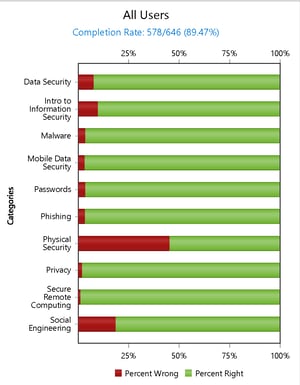Congratulations - you've made it to a point that most companies have not - you're actually going to be training your employees on cybersecurity!
You want to connect with your employees on a whole new level and strengthen the human firewall within your organization. You want to create a security-conscious culture.
Sounds great, right?
Well, to some degree it should feel like a BIG win. 95% of all cyberattacks are caused by human error - so, the fact that you'll be training your workforce means that you're taking a proactive approach to reducing your risk of a security-related incident. Here's where the problem lies - how will you know if you're deploying the right training topics at the right time? How do you know where to start if you don't know your workforce's strengths and weaknesses surrounding cybersecurity? These are the questions that have plagued many organizations. The last thing you want to do is deploy training JUST to deploy training - you want it to work, right?
So, what cybersecurity topics should you train your people on? For most companies, that's a really hard question to answer. They end up just throwing darts at a board and whatever topics they hit, they assign to their team. They end up selecting a few popular topics - phishing, password security and social engineering - but they fail to recognize the true needs of their team. Sure, the aforementioned topics are important, especially since most cyberattacks happen because of things like phishing and password fatigue, but what about topics like social media, malware, ransomware, working remotely, incident response and mobile device best practices? What if your team is struggling the most when it comes to physical security? How would you know? How would you know what topics mean the most to your team? It truly is 'throwing darts at a board.'
If you want to deploy a training program that changes employee behavior, it's critical that you provide them training courses that address their biggest weaknesses. Identifying their weaknesses isn't as hard as you think - or at least it doesn't have to be.
Set Your Baseline
In order to deploy an effective security awareness training program, you must first establish the baseline for your team. In other words, you must first identify your strengths and weaknesses. At TechGuard Security we recommend starting with a Multi-Topic Foundational Course. This course educates and tests your employees on a wide variety of cybersecurity topics. After your team finishes this course, we can identify and quantify the topics where your team performed the best, and where they performed the worst. This 'report' is called our Employee Threat Profile. Here's an example of what an Employee Threat Profile looks like:

The idea is to take the results from the Employee Threat Profile, sprinkle in the major topics like phishing, password security and social engineering, and then deploy an ongoing regular cadence of training to your employees (we recommend either monthly or quarterly).
It may seem like a lot of pressure at first...'Am I doing this right? Am I deploying the right courses? Am I assigning enough courses? Am I assigning too many courses? Is this the best possible training program for my team?'
Don't let the pressure get to you - instead, let us help you! At TechGuard Security our mission is to help you build a security awareness training program that covers the most important topics so that you can reduce your risk and strengthen your human firewall. From course selection to cadence, we are there to help make this EASY.
Want to give it a try? No problem! You can try one of our Multi-Topic Foundational Courses for FREE today. Load your users, assign the course, see the results.
Set your baseline for free today!
Written by Mike Ludgate
Michael serves as the Sr. Manager of the Global Cybersecurity Sales team at TechGuard Security, overseeing corporate business development. For the past two years, Michael has led the TechGuard team to expansive growth and customer acquisition. Prior to joining the TechGuard team, Michael has 10+ years of experience leading various teams in finance, banking, and insurance. His ability to understand a client’s cybersecurity needs provides significant groundwork for ensuring TechGuard’s customers engage in solutions that will effectively prevent an attack or breach.





